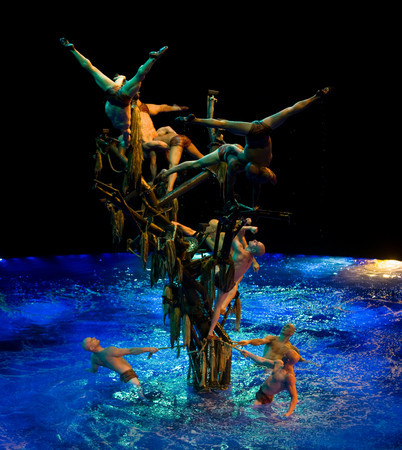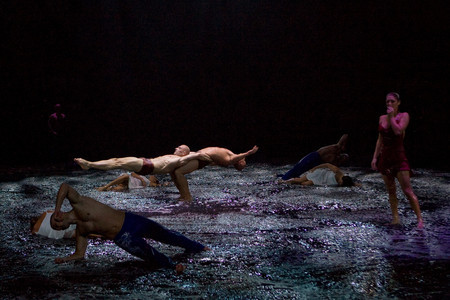Changes to ‘Le Reve’ make production tighter, brighter, more romantic
Perhaps it's fitting for a show about a dream. But the creators of "Le Reve" have grown used to working backward.
The aquatic revue has been in forward motion since its lackluster debut in spring 2005. But this year, finally, is the one where creator Franco Dragone pronounced himself "proud again."
It's also the year creators have been implementing this little thing known as a script.
"It wasn't like we did all that (technical work) and then discovered it was missing. It was just like the next piece of the puzzle we were able to put in," explains artistic director Brian Burke. "Even technically, we had to work backwards."
It has been Burke's job to provide continuity and to coordinate the many cooks in the "Le Reve" kitchen. The diverse talents include puppeteer Michael Curry, whose signature work for "The Lion King" finally made it to the Strip this year; choreographer Maksim Chmerkovksly from "Dancing with the Stars"; and Wynn Resorts Chairman Steve Wynn -- whose personal input stems from "Le Reve" being owned by the company, in Old Vegas fashion, rather than outside producers.
Collectively, they have transformed "Le Reve" from a dull, dark reminder of better shows Dragone created for Cirque du Soleil to a tighter (75 minutes), brighter, more romantic and linear spectacle (read the review for more).
"It took us a while to find it," Burke says of the show's "unique journey." But "the show's in a really amazing place right now. We've reached a really proud place."
Perhaps the real story was backstage. It's too late to roll cameras on a reality series, so a recap will have to suffice: "Le Reve" seems a sure thing, but lays an egg. Partners fight like brothers and one takes a walk, but can never quite leave the baby behind.
"Le Reve" reunited Dragone with casino developer Steve Wynn, continuing the alchemy that came with "O" and "Mystere" after Wynn guided Cirque's vision to the Strip.
But while Dragone was busy with his first big assignment as a freelance director -- Celine Dion at Caesars Palace -- the "Le Reve" concept transformed from a short outdoor production to an indoor spectacle in-the-round.
And a $12 million budget -- on top of $75 million for the bells and whistles of the theater -- didn't seem so lavish once Cirque spent north of $200 million for "Ka" at the MGM Grand.
"We had to deliver a huge thing, we had to impress," Dragone later noted. The Wynn show debuted after only a week of run throughs in April 2005, for a benefit audience of community movers and shakers. They weren't impressed by the sluggish pace, or disturbing touches such as pregnant women crashing into the water.
The Belgian director kept tinkering, toning down the darker elements and changing the central "everyman" character from a man to a lovelorn beauty (now played by Marcia Moreno). But within a year, Wynn bought Dragone out of the show for $16 million.
Wynn and Dragone each say the other is like a brother to him. But brothers argue. Burke diplomatically cites one example: "They both believe there has to be humor. But they have different senses of humor."
Dragone later explained, "You know that in a boat there is the owner and there is the captain. If you want to steer and drive the boat yourself, maybe you're not going to reach your destination." He stayed involved in the show, but on a more periodic basis and as part of a larger team.
By early 2007, the expanded team included Chmerkovksly -- who had helped stage private parties and events for the casino -- and Broadway lighting designer Jules Fisher. That March, the show went dark for several weeks while new lighting was installed overhead and the seating redesigned for comfort; scaled down from 2,087 to 1,606 with a VIP row on top.
Composer Benoit Jutras replaced more than half his own music, and Chmerkovksly's addition of ballroom couples on the circular rim around the pool gave a synchronized swimming scene new purpose. The unanimous enthusiasm for that scene encouraged everyone that it was possible to move the show on a new path, one less reminiscent of Cirque.
The revue still lacked a climactic knockout punch. "We knew we wanted it to have this romantic tone at the end," Burke explains. "It was always a wish of ours to change the room. Wouldn't it be amazing if the entire theater blooms into an atrium?"
Enter Curry, fashioning giant flowers out of parachutelike material.
Dragone's recent visits have been devoted to sharpening the story and focusing the audience's ability to follow the dreamer on her journey. "This is Franco's area of expertise. This is where he has the most fun," Burke says.
Dragone and other creators are due for another visit next week, reminding Burke that two things will never change about "Le Reve."
First, there always will be many hands stirring the pot. "That's the way it always will be and that's this show," he says with a laugh.
The other reality is that "it will never be done." And that's fine by him. Some call it a dream. He prefers to think of it as "a living, breathing piece of art."
Contact reporter Mike Weatherford at mweatherford@ reviewjournal.com or 702-383-0288.
Slideshow
















